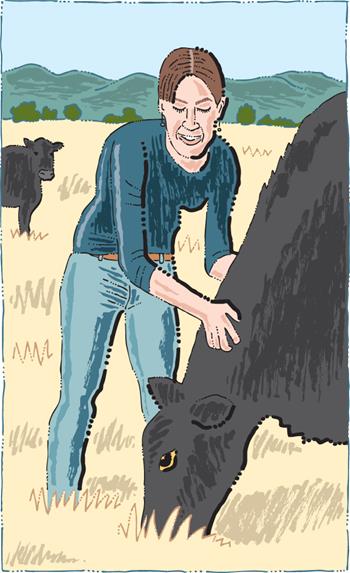Cory Carman grew up in the Wallowa valley in eastern Oregon, the fourth generation on her family’s cattle ranch. On the wall in her office, she has a map of the surrounding land. She can point out which plots were purchased by her great-grandfather a century ago, and chart how the land was later split between uncles and cousins. Her grandmother, who lived ninety years on the ranch, probably knew the area better than anyone. As Cory describes it, “She had a profound knowledge of our land; where the water pooled when it rained, when the elk moved down, the hidden draws where the cows hid.”
Cory didn’t intend to follow in her grandmother’s footsteps and become a rancher.
Instead she left home, got a degree in environmental policy at Stanford, then spent a few years working on Capitol Hill and in LA. But fifteen years ago, she came home for a summer and saw that the ranch was struggling. She had always thought of the ranch as a sort of retirement project, but she saw that if she didn’t step up then, it might soon go under.
When she took the reins, Carman Ranch, like practically every other cattle ranch in Wallowa county (and in the US), relied on conventional methods. That included treating the grasses the cattle ate with plenty of chemical fertilizers and pesticides. When the calves were weaned—at about nine months old—they’d be sold at auction, then trucked off to feedlots. As Cory took stock of the situation, it was clear to her that those systems were unsustainable. The prairie grasses on the ranch were receding, and every year it was getting harder to support the herd of 300 cattle. At college Cory had done a work-study project on grass-fed beef; at the time, she only found 50 ranches attempting it in the US. Nevertheless, she felt passionately enough about it to convince her family to give it a shot.
Producing grass-fed beef is first and foremost about producing great grass.
The new system would use no fertilizers, limited irrigation, and regular, methodical movement of the herd onto small patches of grass, grazing the animals the way grasslands evolved with herds of elk or buffalo.
“When I first moved back and started changing the way we raised cattle on the ranch, my grandmother was really disappointed. She had grown up in pre-industrialized agriculture, and she saw a lot of the changes that happened during her life as a sign of progress. When I stopped using fertilizer and chemicals, she felt like we were going backwards,” Cory says. But before too long under Cory’s management, the grass bounced back, lush and bountiful.
The grass was only one part of the equation. The point of growing great grasses is to harness their nutrients via great beef. Doing so requires a deep knowledge of both grass and cattle. Cory can tell you all about the various components of grasses, and which parts contain more proteins or more carbohydrates, and how those components change as the grass grows. She uses that knowledge to put the right cattle on the right pastures. Younger cattle need more protein to build bones and muscle, so they benefit from grazing on younger grasses. As grass grows older and taller the proteins tend to die away, making those grasses better for older cattle that need more carbohydrates to help them put on fat. And all cattle do best on the richer, more varied grasses of the summer. When grass-fed cows are brought to market while the grass has little nutritional value, the beef is much tougher and chewier. Cory’s cattle spend their whole lives outdoors on Carman Ranch, eating the lush, bountiful prairie grasses. She only brings them to market between May and November, when the grasses are at their richest and the beef is at its most flavorful.
The results speak for themselves.
The beef is tender and juicy. The flavor tends to be a little earthier and more mineral, with a huge, robust beefiness. And it’s won over even the toughest of critics. “After I’d been back on the ranch for several years,” Cory remembers, “my grandmother finally looked at me and said, ‘you know, you’re doing it the way my mom did it.’ That was the best compliment she could have ever given us.”

